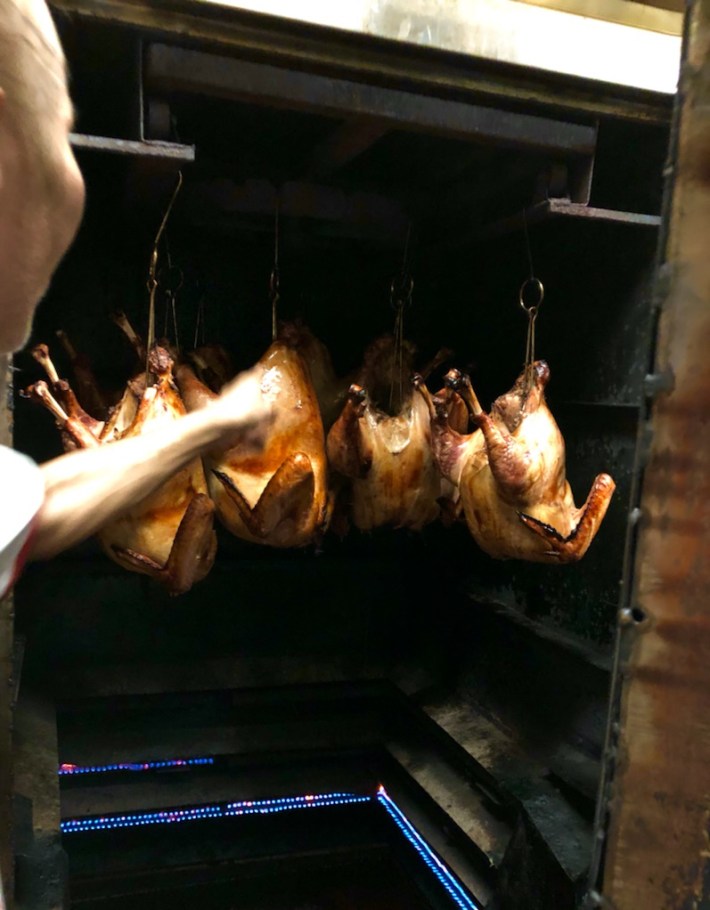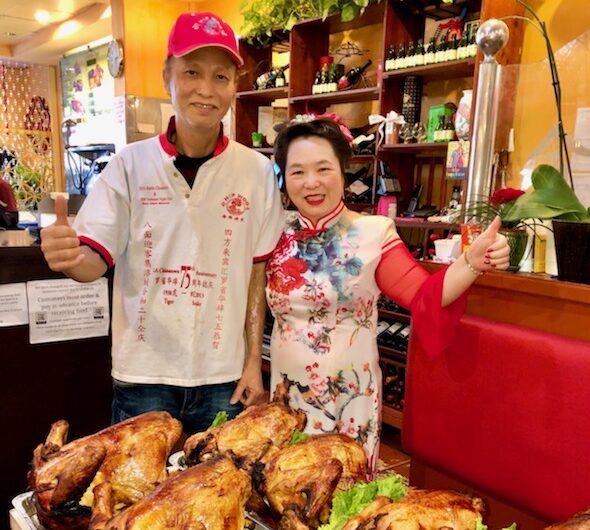Even though chef Lupe Liang of Hop Woo BBQ & Seafood Restaurant introduced the Chinese turkey to Chinatown way back in 1993, it wasn’t his first time roasting a Chinese Thanksgiving turkey. He started cooking his special brand of “Fire Chicken, ”what the Chinese call turkey, years prior when he was a young cook at his uncle’s Chinese restaurant in Tijuana, Mexico.
Because it is on the border of the United States, every year around the time of America’s Thanksgiving, there is also a celebration of “Mexican Thanksgiving.” While Thanksgiving north of the border is for fetng a bountiful harvest, in Mexico, it is more a day of religious observance and an occasion to give thanks for all that’s good in life. Of course, all this spiritual gratitude can work up a ferocious appetite and culminate in a feast that may also include turkey.
“I learned to roast my first turkey in a Chinese restaurant in Mexico for Mexican Thanksgiving, so my recipe is different from American turkey,” said Liang. “I make Chinese turkey for Mexican taste.”
When Liang ultimately immigrated to the U.S. and acquired his own restaurant Hop Woo in 1993, he continued his tradition of making Chinese turkey for the holidays. It should be noted that turkey isn’t particularly a favorite fowl in Chinese cuisine. Turkey isn’t native to Asia, and only in the last two decades, because of a slight rise in the popularity of American Thanksgiving as a thing in China, where it’s known as “Turkey Festival” in some establishments promoting the day, have turkey imports crept up in China.
Further, turkey meat suffers from a reputation for being dry—not very appealing to a culture that celebrates super succulent Peking duck and Hainan chicken. Therefore, winning over the palates of Chinatown’s residents was imperative if it was to be included in the Chinese-American version of the Thanksgiving table, which already comprised of sticky rice with xiang chang (Chinese sausage), steamed flounder, fragrant fried noodles, steamed gai lan with oyster sauce, and other harvest day favorites.

For Chinatown’s inaugural Thanksgiving fire chicken, Liang chose to put all his culinary training from China, Mexico, and his new home, America, into the turkey’s preparation, cooking, and serving. Ingredients and techniques representing Mexican, Chinese, and American cuisines were worked on and into the birds.
Liang closely guards his roast turkey recipe, so much so that he only puts together the elements for the dry seasonings and wet ingredients when his kitchen staff has gone home for the night. He wanted to achieve a flavor that was unique to his turkey but also tasted of traditional American ones as well as his rendition in Mexico. “Mexican basil is one of the ingredients,” shared Liang. This explains the slightly sweet, cinnamon-spiciness of Hop Woo’s turkey.
He also roasts the turkeys the same way he does his popular ducks–an ever-present display at the restaurant, dangling like delicious baubles in Hop Woo’s barbeque case. Inside a massive, commercial duck roaster, you’ll find a dozen or so turkeys hanging tail (open end) up with the neck cavity (at the opposite end) sewn shut.
“I put the turkey butt up, so the juice drip down inside, and flavor stay inside. Makes very juicy meat. Not dry,” explained Liang.
This method adapted from roasting ducks becomes a self-basting technique to maximize the moistness and flavor. If you’ve ever had Chinese roast duck, the eating experience of Hop Woo’s turkey is near to it. And it’s not just the tenderness of the flesh. It’s also in the crackly crispiness of the golden-brown skin, which has been brushed with red vinegar and Manuka honey.
Ten years ago, after a local news segment featured Hop Woo’s Chinese turkey, the restaurant sold almost 350 turkeys during one Thanksgiving season, a record number of sales. The response was so tremendous it got the attention of Hop Woo’s competitors. The following year, several Chinatown restaurants began selling their own Chinese turkey.

“The other restaurants’ turkey taste like Chinese roast duck. Not special. They try to copy me. They can not copy my flavor.” said Liang.
Even during the devastating 2020 pandemic year, Liang sold over 100 turkeys.
Liang encourages customers to pre-order their turkeys at least three days in advance. However, he is willing to accept orders with as little as two hours’ notice up to the day before Thanksgiving—but only if he has any turkeys left.
Turkey is in short supply this year, along with everything else, it seems. The price of turkeys has gone up too, but Liang is doing his best to keep costs low. For 60 dollars, you get a whole roasted Chinese turkey, with turkey garlic fried rice, and turkey liver gravy.
If you really want to go gizzards out, then Hop Woo’s eight-course turkey feast is the call. Included with the meal: turkey, rice noodle in turkey soup, minced turkey in lettuce cups, moo shu turkey, turkey garlic fried rice, curry turkey, lemon sauce turkey, turkey salad, and turkey liver gravy. Yours for 158 dollars. It feeds 8 to 10 people.
Don’t stress if you missed your chance at trying Chinese turkey for Thanksgiving because Hop Woo starts taking orders for the Christmas holiday as soon as Thanksgiving 2021 wraps. Then you’ll probably have enough turkey leftovers to last into 2022.
Hop Woo BBQ & Seafood Restaurant (Chinatown)
845 N Broadway, Los Angeles, CA 90012







